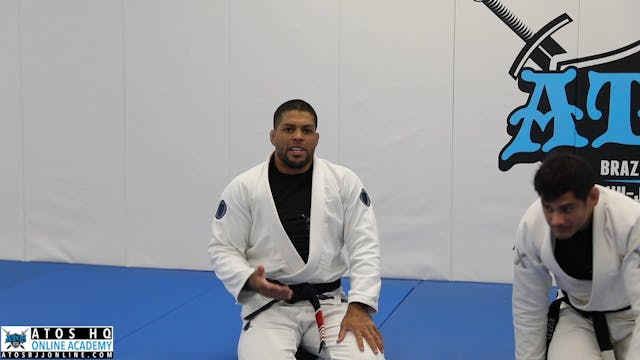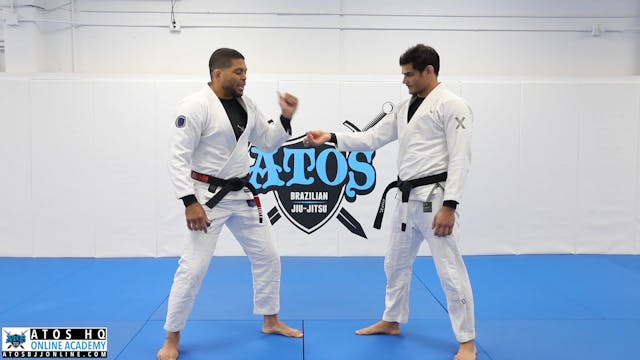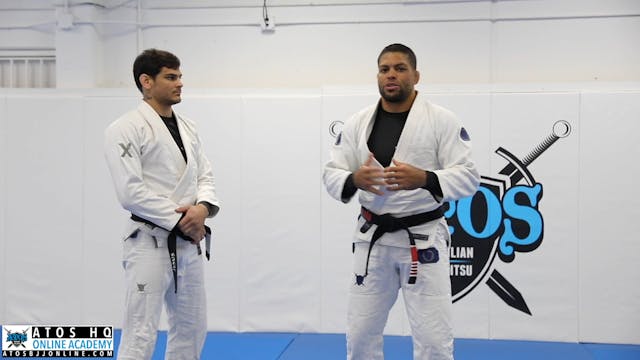Warm-Ups:
It is important to warm up your body before doing any of the physical training in jiu-jitsu. Use the following warm-ups to prepare your body for the techniques you’ll be practicing with repetition. These warm-ups are also fundamental movements for jiu-jitsu as a whole, so practice them with care and add speed as your accuracy improves.
1- STAND UP IN BASE: Standing up in base is one of the most important basic movements we have in jiu-jitsu. It is great for warming up because it gets your hips and quads warm, but it also works on your balance and dexterity. In jiu-jitsu, it’s an important movement for self-defense as it helps you retreat from a downed position to a neutral standing one without leaning your weight forward into your opponent. This movement is vital to many sweeps, reversals and guard techniques as well.
2- SEATED UP ESCAPE: The seated escape is the fastest way to move while in a downed guard position. You should focus on keeping as little contact with the mat while using the powerful tripod created by your posted hand, hips, and feet to quickly propel yourself across the mat to defend against a standing guard passer
3- ANKLE PICK SIT UP: You must repeat it in order to get better agility to fulfill your attacks from the bottom. This is a very essential movement of body mobility for Jiu-Jitsu.
4- COMBO: The combination of the first three warm-ups.
5- BASIC GUARD RETENTION: In this warm-up/technique you will be able to understand the importance of keeping your opponent between your legs when you are on the bottom.
6- HIP ESCAPE: The hip escape is integral to good bottom space-creating movement in jiu-jitsu. You can do these stationary (in one place) or across the mat for a more vigorous warm-up. You will use these hip escapes (also called shrimp or ebi) in your training every day. Really exaggerate your movement to maximize the effect of your hip escape
7- PARTNER GUARD RECOVERY DRILL: This is an excellent drill to practice mount escapes while creating the tenacity and hip extension to es-cape against your toughest partner. You should do this across the mat exercise with only forward step-ping pressure from the top partner as they pursue you from one side to the other.
8- PARTNER GUARD RECOVERY DRILL 2 “THROWBY PASS DEFENSE”: This partner drill is a little more dynamic than the last drill because both partners get to work a little bit. The person on top does a throw-by guard pass to clear the legs and the person on bottom recovers guard by stepping to the hips to regain contact. This is a great way to warm up your bodies and get ready for class.
9- PARTNER GUARD RECOVERY DRILL 2 “ROCKING CHAIR ESCAPE”: This is also an excellent defensive recovery drill against the throw-by pass, this time your partner passes radically toward your backside and you must utilize an inversion to recover the guard. Be sure your partner takes a step after throwing your legs to ensure you have a point of contact for your recovering foot.
10- UNDERSTANDING THE CONCEPTS OF GUARD RETENTION AND GUARD RECOVERY.
11- FORWARD ROLL: The FORWARD roll or FRONT roll is a great way to simulate a fall from a forward throw like the hip toss. The goal is to learn how to fall safely and properly. You want to be sure you protect your neck so always keep your chin pinned to your chest. When you complete the roll, be sure to slap your hands to the mat at your waistline to break your fall. The force of the fall is spread throughout your wingspan instead of just across your back, so you reduce the risk of injury and that dreaded feeling of getting the wind knocked out of you.
12- FORWARD ROLL 2: The Forward roll 2 is a great way to simulate a fall from a forward throw like the hip toss. The goal is to learn how to fall safely and properly. You want to be sure you protect your neck so always keep your chin pinned to your chest. When you complete the roll, be sure to slap your hands to the mat at your waistline to break your fall. The force of the fall is spread throughout your wingspan instead of just across your back, so you reduce the risk of injury and that dreaded feeling of getting the wind knocked out of you.
13- BACK ROLL: The Back Roll is used to prepare the student for backward falling throws like leg trips and wrestling tackles. The breakfall mechanism is similar to the front roll with the exception that the breakfall happens at the beginning of the motion instead of at the end. Use your momentum from slapping the mat with your hands to help pull yourself over your own shoulder
14- WARM-UPS REVIEW
Up Next in White Belt - The Path to Stripe #1
-
Self Defense Day 1
TECHNIQUES:
1- HIP THROW “O-GOSH”: The O-Goshi hip throw is the first takedown you’ll learn in this program. In this technique, the fulcrum is your hips shooting across their hipline, creating a perfect obstacle to hurdle your opponent over. Focus on a deep entry of the hip combined with a stron...
-
Self-Defense DAY 2
TECHNIQUES:
1- DEFENDING THE SAME-SIDE WRIST GRIP: The same-side wrist grip defense is important for both gi, no-gi, and self-defense training and is key to later grip fighting and more competitive training scenarios. When you’re escaping a grip like this, your partner’s thumb to forefinger “ho...
-
Self-defense DAY 3
TECHNIQUES:
1- FRONT CHOKE DEFENSE WITH HIP THROW: With your knowledge of the Koshi-Guruma headlock takedown its time to apply this to a real-world self-defense situation. In this case, you focus on regaining the inside control, a fundamental jiu-jitsu concept to create separation from the choke...




2 Comments